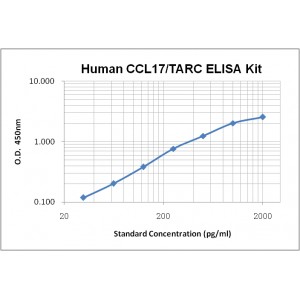More info
Assay Range | 31.2-2,000 pg/mL |
Sensitivity | 1.0 pg/mL |
Specificity | No cross-reaction with other related substances detected |
Size | 96T |
Storage | Store at 2 - 8ºC. Keep reconstituted standard and detection Ab at -20 ºC |
Assay Principle | Sandwich ELISA |
Sample Volume | 100 µL final volume, dilution factor varies on samples |
Detection Method | Chromogenic |
Kit Components
1. Recombinant Human CCL17 standard: 2 vials
2. One 96-well plate coated with Human CCL17 Ab
3. Sample diluent buffer: 12 mL - 1
4. Detection antibody: 130 µL, dilution 1:100
5. Streptavidin-HRP: 130 µL, dilution 1:100
6. Antibody diluent buffer: 12 mL x1
7. Streptavidin-HRP diluent buffer: 12 mL x1
8. TMB developing agent: 10 mL x1
9. Stop solution: 10 mL x1
10. Washing solution (20x): 25 mL x1
Background
CCL17, also known as thymus and activation regulated chemokine (TARC), or small-inducible cytokine A17, is a small protein of the CC chemokine family. CCL17 is expressed primarily in thymus and at low levels in the lung, colon and small intestine. CCL17 is a ligand for the chemokine receptor CCR4, which is expressed on PBMCs and human T-cell lines but has not yet found on B cells, NK cells, or granulocytes. CCL17 is the closest homolog of Macrophage-Derived Chemokine (MDC) in the CC chemokine family. MDC competes with CCL17 for binding to CCR4. CCL17 also binds to the chemokine receptor CCR8. Expression of CCR4 and CCR8 is transiently up-regulated on activated T cells, preferentially on the Th2 subset. The chemotactic effects of CCL17 in T cells make it an important biomarker for allergic diseases such as atopic dermatitis, allergic asthma, allergic rhinitis, and allergic contact dermatitis. CCL17 also has been detected in idiopathic pulmonary fibrosis.


